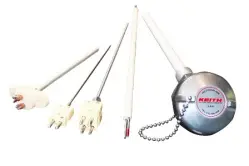Temperature Measuring in Furnaces and Kilns
Pyrometric devices such as cones, rings and bars are gauging the heat work performed (time + temperature). They do not measure temperature per se, they only show temperature equivalents.
Contact temperature sensors
- Thermocouples can measure the widest temperature span.
- RTD are very repeatable and accurate.
- Thermistors are the most accurate for a limited temperature span.
A rudimentary temperature stick is sometimes used in the forging industry to determine the forging temperature. This is not considered temperature measuring because it only tells if the temperature is higher than the reaction temperature of the stick.
Non-contact temperature sensors
All types of infrared sensors (also called pyrometers, spectral meters and radiation meters) are non-contact sensors.
Today, non-contact temperature measuring devices are still a black box for most operators. Some reasons may be that infrared radiation is invisible to the human eyes. Infrared sensors are either handheld or fix installed.
Handheld infrared temperature sensors
Handheld infrared thermometers do have limitations if the emissivity of the application is changing with temperature. If so, a frequent emissivity parameter change on the shop floor may not practical. Today, you can purchase a handheld infrared temperature sensor for less than 100 dollars and this type of sensor may give satisfactory results depending on application.
Fix installed infrared temperature sensors
This type of sensor is far more sophisticated than handheld sensors. The biggest differences are in the optics, the advanced filtering capabilities and the options to include multi-wave length sensor technology and data-collection.






